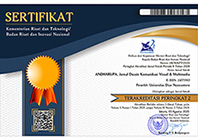Perancangan Media Pembelajaran Berbasis Audio Visual untuk Mata Kuliah Tipografi pada Program Studi Desain Komunikasi Visual Universitas Dian Nuswantoro
DOI:
https://doi.org/10.33633/andharupa.v3i01.1335Abstract
Abstrak Tipografi merupakan salah satu mata kuliah pada bidang desain komunikasi visual yang mengutamakan aspek visual. Namun berdasarkan hasil observasi diketahui bahwa media pembelajaran yang selama ini digunakan kurang efektif karena kurangnya pemanfaatan teknologi informasi, sehingga mahasiswa kurang maksimal dalam memahami materi kuliah yang disampaikan oleh pengajar. Perkembangan teknologi informasi saat ini banyak memberikan dampak positif bagi kemajuan bidang pendidikan diantaranya dapat digunakan untuk mendukung media dalam proses pembelajaran. Tujuan penelitian ini adalah merancang media pembelajaran untuk mata kuliah tipografi dengan memanfaatkan teknologi informasi yaitu media audio visual. Metode yang digunakan dalam penelitian ini adalah Research and Development dengan pendekatan model ADDIE (Analysis, Design, Development, Implementation, Evaluation). Dengan diciptakannya media pembelajaran audio visual ini diharapkan proses pembelajaran mata kuliah Tipografi dapat lebih efektif dan materi kuliah lebih mudah dipahami oleh mahasiswa.  Kata Kunci : audio visual, media pembelajaran, tipografi AbstractTypography is one of the subjects in the field of visual communication design that prioritizes the visual aspect. However, based on the observation note that the media has been used less effective because the lack of use information technology, so students can't understand the course material that explained by lecturers. Today, the development of information technology is being positive impact for the advancement of education which can be used to support the media in the learning process. The purpose of this research is to design learning media for the course of typography by utilizing information technology, called audio-visual media. The method that used in this research is Research and Development with ADDIE model (Analysis, Design, Development, Implementation, Evaluation). With the creation of audio-visual learning media is expected Typography learning courses can be more effective and the course material more easily understood by students. Keyword : audio visual, instructional media, typographyReferences
Nini Subini, dkk. 2012. Psikologi Pembelajaran.Yogyakarta : Mentari Pustaka
Kusrianto, Adi. 2004.Tipografi Komputer untuk Desainer Grafis,Yogyakarta: ANDI
Haryoko S. 2009. Efektivitas Pemanfaatan Media Audio Visual sebagai Alternatif Optimalisasi Model Pembelajaran. Jurnal edukasi 5 (1) : 1-10.
Arsyad, A. 2009. Media Pembelajaran. Jakarta: Raja Grafindo Persada.
Aqib, Zainal. 2002. Profesionalisme Guru dalam pembelajaran, Surabaya: Insan Cendekia.
Sihombing, Danton. 2001. Tipografi Dalam Desain Grafis. Jakarta: Gramedia.
Rustan, Surianto., 2010. Huruf Font Tipografi, Jakarta: P.T Gramedia Pustaka Utama.
Sink, Darryl L. 2014. Design Models and Learning Theories for Adults. American Society for Training and Development.
Chaeruman. 2008. Mengembangkan Sistem Pembelajaran dengan Model ADDIE. Jakarta: PT. Remaja Rosdakarya.
Moleong, L. J. 2005. Metode Penelitian Kualitatif. Bandung: PT. Rosdakarya
Suharsimi, Arikunto. 2012. Dasar-dasar Evaluasi Pendidikan edisi 2, Bumi Aksara, Jakarta.
Downloads
Published
Issue
Section
License
Copyright (c) 2017 ANDHARUPA: Jurnal Desain Komunikasi Visual & Multimedia

This work is licensed under a Creative Commons Attribution 4.0 International License.
Authors who publish with this journal agree to the following terms:
- Authors retain copyright and grant the journal right of first publication with the work simultaneously licensed under a Creative Commons Attribution License that allows others to share the work with an acknowledgment of the work's authorship and initial publication in this journal.
- Authors are able to enter into separate, additional contractual arrangements for the non-exclusive distribution of the journal's published version of the work (e.g., post it to an institutional repository or publish it in a book), with an acknowledgment of its initial publication in this journal.
- Authors are permitted and encouraged to post their work online (e.g., in institutional repositories or on their website) prior to and during the submission process, as it can lead to productive exchanges, as well as earlier and greater citation of published work (See The Effect of Open Access).















